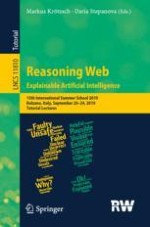2019 | OriginalPaper | Buchkapitel
Explaining Data with Formal Concept Analysis
verfasst von : Bernhard Ganter, Sebastian Rudolph, Gerd Stumme
Erschienen in: Reasoning Web. Explainable Artificial Intelligence
Aktivieren Sie unsere intelligente Suche, um passende Fachinhalte oder Patente zu finden.
Wählen Sie Textabschnitte aus um mit Künstlicher Intelligenz passenden Patente zu finden. powered by
Markieren Sie Textabschnitte, um KI-gestützt weitere passende Inhalte zu finden. powered by
